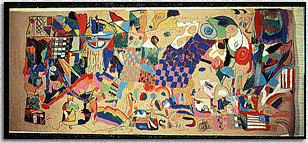Started firing the electric kiln at midnight last night in hopes that the technician's new approach to the digital programming would work.
Since the kiln never misfires in the lower temps, thought it would be ok to start it at midnight, sleep through the lower firing range and check it around 7am this morning when in theory it should have reached 1200 degrees F.
However, woke up every hour on the hour to run out to the garage to check the kiln. Couldn't get into a deep sleep and at one point, sat up and watched the stars twinkle thru the windowpane from 2:55am til 4:20am.
At 11:29am temps have reach 1959 degrees F so the verdict is still out as to whether the kiln will reach the programmed temp of 2200 degrees F.
In the meantime, yesterday for no reason at all, the phrase: "art design and visual thinking" just popped into my head.
Googled it.
Have only explored 2 pages of the results but find the information most interesting. Evidently, there is a whole school of theory on visual thinking !!!
Will try and import here some information from one of the many sites Google came up with. The site is: http://www.public.iastate.edu/~design/ART/NAB/FleFlu.html
Some info quoted from this site:
Flexibility: A universal condition that fosters productive thinking by allowing the individual to be very responsive to change and adaption of new methods and forms without doing damage to the original goal or vision. Flexible thinking is characterized by easy access to subconscious as well as conscious levels of thinking. The flexible visual thinker should be proficient in a variety of mental operations and be able to move freely from one operation to another with a free choice of vehicles (such as media, style, subject matter, type of configuration, etc.).
Flexibility: A universal condition that fosters productive thinking by allowing the individual to be very responsive to change and adaption of new methods and forms without doing damage to the original goal or vision. Flexible thinking is characterized by easy access to subconscious as well as conscious levels of thinking. The flexible visual thinker should be proficient in a variety of mental operations and be able to move freely from one operation to another with a free choice of vehicles (such as media, style, subject matter, type of configuration, etc.).
The fact that whoever the artist is was transposing the imagery of a clothespin intrigued me.
Fluency: The freely flowing and seemingly effortless expression of visual thinking through an observable behavior; production of a large quantity of potentially useful responses.
Randomness: Any strategy activity where specific conscious purpose, organization or structure is minimized in order to allow the artist to discover new patterns to which he or she may respond in a unique manner; haphazard appearance to behavior.
Randomness: Any strategy activity where specific conscious purpose, organization or structure is minimized in order to allow the artist to discover new patterns to which he or she may respond in a unique manner; haphazard appearance to behavior.
Reflectivity: is the mental skill of giving careful consideration to visual configurations which are already present in perception. Distinguishing between this quality and the more usual tendency to verbalize and rationalize unformed ideas, present only as mental states, is vital to the development of an effective visual thinker.
This is just the tip of the iceberg!
Will research further, but for now have to run to the other end of the house and out to the garage to check on the kiln . . . .
Have a happily "awake" day!
Chae











No comments:
Post a Comment